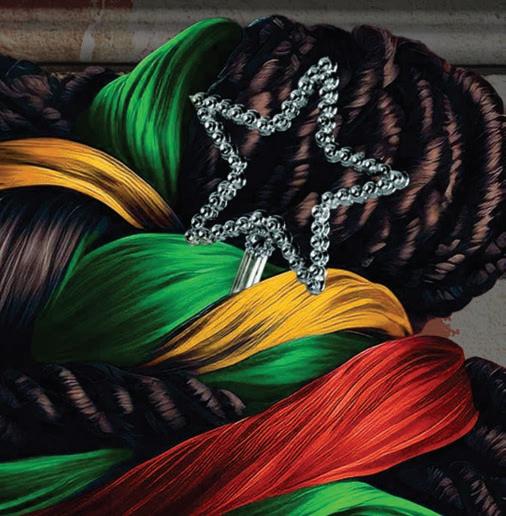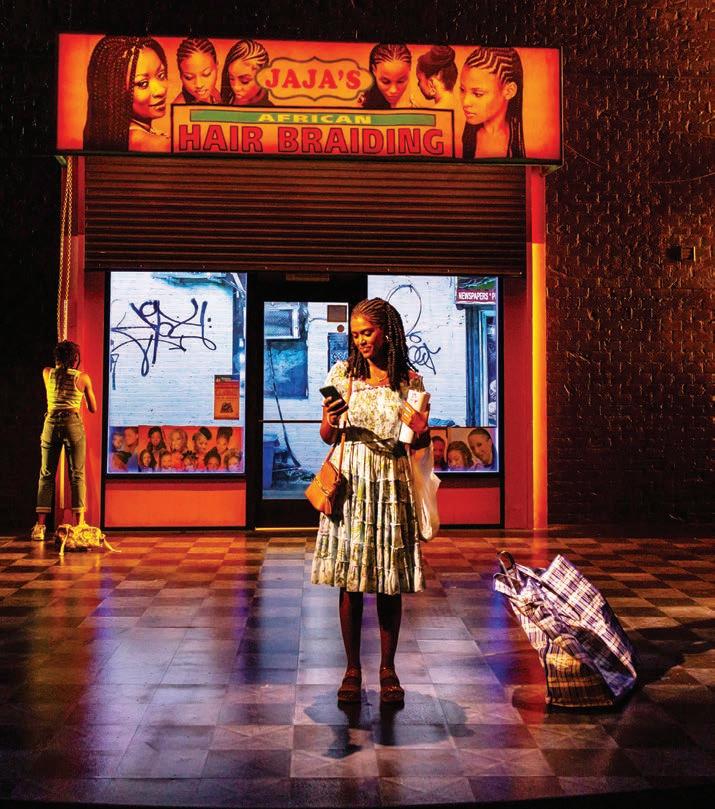
5 minute read
Hair Story / History / Here Story
By Otis Ramsey-Zöe
In Jaja’s African Hair Braiding, within the arc of a single day, Jocelyn Bioh threads many lives from varying origin points on the globe into a stunning, unified tapestry.
For each braider, it took a whole lot of trying just to get up that hill. Each worker in Jaja’s shop earned her spot through determination, skill, and the ability to navigate hostile systems. This “a day in the life of” story centers not on one individual but on an entire community invested in perpetual works of service, esteem-building, citizenship, self-making, and heritage preservation. According to Bioh, from an interview with legendary playwright Lynn Nottage, “There’s something really powerful about when the story is the main character, or the place is the main character.”
Jaja’s is a particularly rewarding work because it is layered and dramatizes interior and exterior complexities. Walking in, the title signals that this is a hair story, but it is also a here story infused with deep culture and history.
HAIR STORY.
It’s a quiet and hot Summer morning on 125th and St. Nicholas Avenue in Harlem. The hair braiding shop owned by Jaja, like so many hair salons and barbershops in Black and immigrant communities, functions as a community center, as a hub for information, commerce, and image-making.
Physical appearance and presentation are not mere vanity. Despite progress on all fronts social, political, legislative, and the like, the way a person’s appearance is read by another can determine how they are treated. In the lexicon of social codes, hair functions as a key ethnic signifier because, compared with bodily shape or facial features, it can be changed more easily.
Even mogul Oprah Winfrey has encountered numerous incidents of racial profiling while out shopping. Following one occurrence, comedian Paul Mooney joked, “Oprah should’ve combed her hair,” which recognizes that Black women face an inordinate amount of stigma, judgment, and assumptions based on how they wear their hair. Art historian Kobena Mercer asserts, “all black hairstyles are political in that they each articulate responses to the panoply of historical forces which have invested this element of the ethnic signifier with both social and symbolic meaning and significance.” Since hairdos function within systems of codes, values, and meanings, clients in Jaja’s shop are selecting a story to embody; they are negotiating which aspects of themselves and culture to highlight, curb, fabricate, explore, honor, and project. Of course, a persistent aspect of history and historical forces is the reality of their ever presence.
HISTORY.
History is capacious. It is not simply written down or spoken. History may also be embodied. History shows up in our body movements, actions, and even apparel.
Bioh expertly and slyly signals an entire history lesson at the very top of the show by indicating that a character carries a particular accessory. Marie, Jaja’s daughter, enters hauling supplies in large once-nameless, checkered, woven matted bags. Immediately recognizable and abundant even here in the United States, these bags acquired the name “Ghana must go” bags following the 1983 expulsion of Ghanaians from Nigeria. Today, the bags have many names including Efiewura suame (by Ghanaian, which means “help me carry this load”), Anyi N’Aga (Igbo for “we are going”), and refugee bags. The bags have become symbols of migration as carriers for possessions, as standins for immaterial things like culture, heritage, and memories that are also being carried, and as reminders of dispossession and forfeiture.

Within the play, these bags are a tiny detail that reveals Bioh’s investment in astutely infusing the characters and story with layers of meaning, history, backstory, tensions, anxieties, dreams, and every manner of the complications that arise from living and striving towards citizenship in a nation that holds opportunities and inhospitality in equal measure. Jaja’s is infused with more meaningful and layered details than can be absorbed in a single viewing, and Bioh crafts a play that feels both timeless and rooted in a very specific time and place.
HERE STORY.
Set on a very hot day in July of 2019 in Harlem, which was declared a Black mecca in 1925 during the Harlem Renaissance, Jaja’s is an immigrant story, yes, but that is also the story of this nation. America has always been seen and represented itself as a “golden door” long before “The New Colossus” by Emma Lazarus was penned or inscribed onto the pedestal for the Statue of Liberty, arguably the world’s most recognizable symbol of welcome to immigrants. 2019 found the country embroiled in fierce debates about the status of and place for immigrants in this country. In 2018, one year before the play takes place, the then-sitting US President expressed in vulgar terms his belief that not all immigrants should be welcomed in these United States. Such debates continue to this day, but questions around how we as a nation handle immigration mirror the dilemma of selecting a hair style. Both are operating within tensions between who we say we are by the image we project (our exterior) and who we show we are based on our actions (our interior). Jaja’s African Hair Braiding is not just about the immigrants represented by the women and men we see on stage in the shop; it is about each inhabitant of this country who either themselves or their ancestors came here from someplace else.



